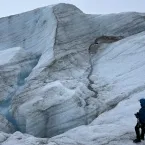Our Research
As climate changes, how do Earth's frozen areas affect our planet and impact society?
In this section
Related News & Stories
Filter by:

Analysis - Sea Ice Today
Air temperatures in December 2024 were above average over the entire Arctic Ocean, continuing the pattern set in November. Average Arctic sea ice extent for December was the lowest in the satellite record, in considerable part due to delayed ice growth in Hudson Bay and low extent in the northern Barents Sea. Antarctic sea ice has declined at a slower-than-normal pace since mid-November, erasing the record and near-record low extents of October and November and finishing the year very close to the 1981 to 2010 average.

Analysis - Ice Sheets Today
Melt events on both sides of the Antarctic Peninsula and along the Dronning Maud coastal ice shelves between December 15 and 19 combined to produce an early-season record melt extent of just below 2 percent of the Antarctic Ice Sheet for December

Spotlight
Most of Greenland’s meltwater takes weeks to reach the ocean. A recently published study highlights an innovative new method to track Greenland’s meltwater movement: monitoring the bedrock under the ice.

Spotlight
Since beginning to migrate data to the NASA Earthdata Cloud, the NSIDC DAAC has worked to develop resources and tools to ensure an easy transition for data users. The newest of those tools to come to the NSIDC DAAC is NASA Earthdata Harmony data transformation services, or Harmony for short, which the NSIDC DAAC has adopted for ICESat-2 data. Harmony is a framework that serves many NASA Earthdata data sets across NASA DAACs. These data transformation services include spatial, temporal, and variable subsetting, reformatting the data, combining multiple files together in one file, reprojection, and more.

Analysis - Sea Ice Today
Following the pattern seen in recent years, autumn freeze up has been slow in the Arctic, reflecting the growing heat gain in the ocean mixed layer during summer and higher air temperatures. In the Antarctic, the rate of spring ice loss slowed somewhat during November, ending the month above the extreme low levels of 2016 and 2023.
